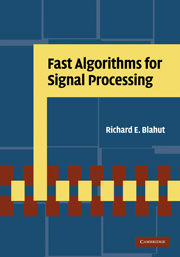Book contents
- Frontmatter
- Contents
- Preface
- Acknowledgments
- 1 Introduction
- 2 Introduction to abstract algebra
- 3 Fast algorithms for the discrete Fourier transform
- 4 Fast algorithms based on doubling strategies
- 5 Fast algorithms for short convolutions
- 6 Architecture of filters and transforms
- 7 Fast algorithms for solving Toeplitz systems
- 8 Fast algorithms for trellis search
- 9 Numbers and fields
- 10 Computation in finite fields and rings
- 11 Fast algorithms and multidimensional convolutions
- 12 Fast algorithms and multidimensional transforms
- A A collection of cyclic convolution algorithms
- B A collection of Winograd small FFT algorithms
- Bibliography
- Index
7 - Fast algorithms for solving Toeplitz systems
Published online by Cambridge University Press: 03 May 2011
- Frontmatter
- Contents
- Preface
- Acknowledgments
- 1 Introduction
- 2 Introduction to abstract algebra
- 3 Fast algorithms for the discrete Fourier transform
- 4 Fast algorithms based on doubling strategies
- 5 Fast algorithms for short convolutions
- 6 Architecture of filters and transforms
- 7 Fast algorithms for solving Toeplitz systems
- 8 Fast algorithms for trellis search
- 9 Numbers and fields
- 10 Computation in finite fields and rings
- 11 Fast algorithms and multidimensional convolutions
- 12 Fast algorithms and multidimensional transforms
- A A collection of cyclic convolution algorithms
- B A collection of Winograd small FFT algorithms
- Bibliography
- Index
Summary
A standard method of solving a system of n linear equations in n unknowns is to write the system of equations as a matrix equation A f = g, and to solve it either by computing the matrix inverse and writing f = A−1g or, alternatively, by using the method known as gaussian elimination. The standard methods of computing a matrix inverse have complexity proportional to n3. Sometimes, the matrix has a special structure that can be exploited to obtain a faster algorithm.
A Toeplitz system of equations is a system of linear equations described by a Toeplitz matrix A. The problem of solving a Toeplitz system of equations arises in a great many applications, including spectral estimation, linear prediction, autoregressive filter design, and error-control codes. Because the Toeplitz system is highly structured, methods of solution are available that are far superior to the general methods of solving systems of linear equations. These methods are the subject of this chapter, and are valid in any algebraic field.
The algorithms of this chapter are somewhat distant from those we have studied for convolution and for Fourier transforms. Convolutions and transforms are essentially problems of matrix multiplication, whereas this chapter deals with the solution of a system of linear equations. The solution of a system of linear equations is closer to the task of matrix inversion. It should be no surprise that we do not build on earlier algorithms directly, though techniques such as doubling may prove useful.
- Type
- Chapter
- Information
- Fast Algorithms for Signal Processing , pp. 231 - 261Publisher: Cambridge University PressPrint publication year: 2010



